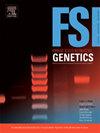STRAF 2: New features and improvements of the STR population data analysis software
IF 3.1
2区 医学
Q2 GENETICS & HEREDITY
引用次数: 0
Abstract
Population data in forensic genetics must be checked for a variety of statistical parameters before it can be employed for casework. Several tools exist to perform such tasks; however, it can become challenging to obtain the right results due to the number of software to use and the broad range of input formats. Furthermore, a substantial amount of experience is required to use some of these programs. To overcome these difficulties, we have developed STRAF (STR Analysis for Forensics), a convenient online tool to analyse STR data in forensic genetics. Since its first release in 2017, it has been used in many studies to report allele frequencies, forensic and population genetics parameters, and to explore genetic datasets interactively through a user-friendly interface. Herewith, we introduce the latest version of the STRAF software and the improvements we have implemented over the last years. STRAF 2 includes several new features, such as new statistical methods (multidimensional scaling, comparison to a reference population, haplotype diversities and frequencies) and file conversion utilities. Performance and user experience have also been improved and documentation has been extended. This new version is freely available as an R package (https://github.com/agouy/straf) and a web application (https://straf.fr).
straf2: STR人口数据分析软件的新功能和改进。
法医遗传学中的人口数据必须经过各种统计参数的检查,才能用于案件工作。有几种工具可用于执行此类任务;然而,由于要使用的软件数量众多,输入格式范围广泛,要获得正确的结果可能具有挑战性。此外,使用其中一些程序还需要大量的经验。为了克服这些困难,我们开发了 STRAF(法医用 STR 分析),这是一款方便的在线工具,用于分析法医遗传学中的 STR 数据。自2017年首次发布以来,它已被许多研究用于报告等位基因频率、法医和群体遗传学参数,并通过友好的用户界面交互式地探索遗传数据集。在此,我们将介绍 STRAF 软件的最新版本以及我们在过去几年中实施的改进。STRAF 2 包含多项新功能,如新的统计方法(多维缩放、与参照群体比较、单体型多样性和频率)和文件转换工具。此外,还改进了性能和用户体验,并扩展了文档。新版本作为 R 软件包(https://github.com/agouy/straf)和网络应用程序(https://straf.fr)免费提供。
本文章由计算机程序翻译,如有差异,请以英文原文为准。
求助全文
约1分钟内获得全文
求助全文
来源期刊
CiteScore
7.50
自引率
32.30%
发文量
132
审稿时长
11.3 weeks
期刊介绍:
Forensic Science International: Genetics is the premier journal in the field of Forensic Genetics. This branch of Forensic Science can be defined as the application of genetics to human and non-human material (in the sense of a science with the purpose of studying inherited characteristics for the analysis of inter- and intra-specific variations in populations) for the resolution of legal conflicts.
The scope of the journal includes:
Forensic applications of human polymorphism.
Testing of paternity and other family relationships, immigration cases, typing of biological stains and tissues from criminal casework, identification of human remains by DNA testing methodologies.
Description of human polymorphisms of forensic interest, with special interest in DNA polymorphisms.
Autosomal DNA polymorphisms, mini- and microsatellites (or short tandem repeats, STRs), single nucleotide polymorphisms (SNPs), X and Y chromosome polymorphisms, mtDNA polymorphisms, and any other type of DNA variation with potential forensic applications.
Non-human DNA polymorphisms for crime scene investigation.
Population genetics of human polymorphisms of forensic interest.
Population data, especially from DNA polymorphisms of interest for the solution of forensic problems.
DNA typing methodologies and strategies.
Biostatistical methods in forensic genetics.
Evaluation of DNA evidence in forensic problems (such as paternity or immigration cases, criminal casework, identification), classical and new statistical approaches.
Standards in forensic genetics.
Recommendations of regulatory bodies concerning methods, markers, interpretation or strategies or proposals for procedural or technical standards.
Quality control.
Quality control and quality assurance strategies, proficiency testing for DNA typing methodologies.
Criminal DNA databases.
Technical, legal and statistical issues.
General ethical and legal issues related to forensic genetics.

 求助内容:
求助内容: 应助结果提醒方式:
应助结果提醒方式:


